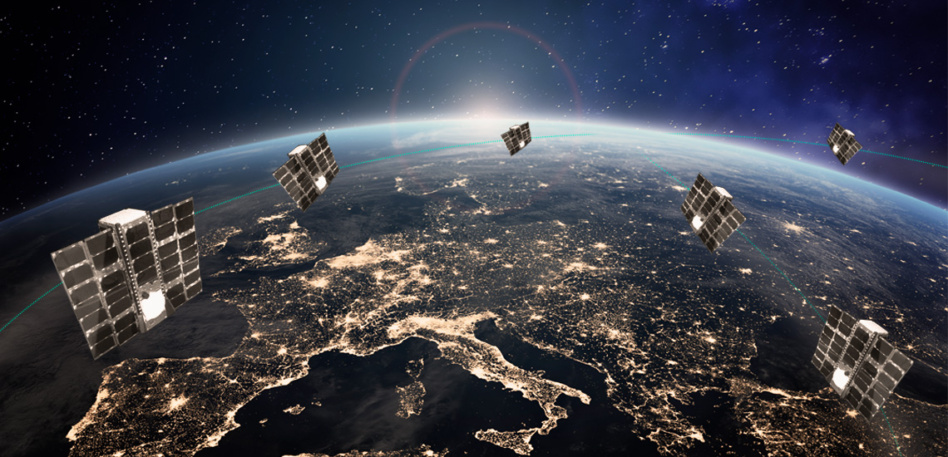There are going to be a lot of cell towers in space. Last week, Sateliot said it was working with Amazon to build a cloud-native narrowband IoT (NB-IoT) 5G connectivity service using its planned LEO constellation on AWS. Now, we’ll run that last sentence through Payload’s jargon translator:
- Cloud-native: a go-to for newer, more nimble satellite operators.
- NB-IoT: a low-cost, high-capacity, and power-efficient way for millions of machines to communicate with one another on Internet of Things networks.
- 5G: the next generation of wireless communication networks.
- LEO: We’ve lost count of how many planned LEO constellations there are.
- AWS: Amazon Web Services, the world’s leading cloud computing provider and more or less the backbone of today’s internet.
The San Diego/Barcelona-based startup hopes to be the first satellite operator to provide global IoT coverage using 5G.
What are the broader implications of narrowband?
The technology has the potential to unlock significant IoT adoption around the world. Think cell towers in the sky for lower latency and more coverage.
Not too long ago, NB-IoT was synonymous with slow and inefficient service. In July 2020, though, the International Telecommunication Union (ITU) officially accepted 5G-based NB-IoT.
- Customers can continue to use the same SIM that they currently use without any additional hardware or device modifications.
- In fact, Sateliot has been contributing to the latest 5G standards release for the last three years.
On the business side. Sateliot primarily partners with mobile network operators (MNOs), rather than selling its own IoT services to end users. The company partnered with Spanish MNO Telefonica in July to test Sateliot’s technology. It plans to conduct its first pre-commercial customer pilots at the end of this year. Sateliot will start deploying its constellation in Q1 2023 and launch commercially in the second half of the year.
$$$: Sateliot banked a €10M Series A in February and tells Payload that it’s in the midst of a €100M Series B.
A word from leadership: Payload caught up with Jaume Sanpera, Sateliot’s CEO, to chat about the above and what’s next. A telco engineer by trade, Sanpera’s resume brings new meaning to the phrase “serial entrepreneur.” Sateliot is his ninth venture in the telecom sector.
Note: This interview was edited for clarity and length.
Tell me about Sateliot’s mission and where you are today.
The mission of Sateliot is to connect 5G IoT devices from around the world through space. This means that we work with exactly the same low-cost devices today that are using MNOs. When they reach places that are out of coverage, we connect directly from our configuration. We launched our first test satellite in 2021. We are launching five more next year.
One of the special characteristics of Sateliot, in comparison to competitors, is that we have patent-pending technology. We are already working on full-standard connectivity with devices, which means that we can launch with very few satellites. We can start a very low-density operation with our five satellites. We can start connecting non-time-sensitive applications like agriculture, cattle management, infrastructure, and logistics. That is what we are going to do next year.
Our channel will always be the MNOs and IoT operators. We do not go directly to the final user because a LEO constellation has lower coverage. That means it’s all about sales. In order to have the best channel to arrive to the market immediately, we are signing with MNOs around the world. We have already signed with MNOs representing more than 47 countries and over 1 billion customers.
But at the same time, we wanted to have better knowledge of the final applications and what the needs of the final users are. Nine months ago, we released the early adopters program which allowed final users to place pre-orders with some service activation. They will have preference when the service is ready. We have already signed more than 300 customers representing more than €1 billion in pre-orders.
What market are you targeting?
Customers of the MNOs. We will be covering the 2 billion customers that the MNOs have today or the 5 billion that they will have by 2025. By 2023, we are going to have only five satellites for non-sensitive applications.
We are talking about four SMS messages per day with one message every six hours. There are some applications that need real-time or near real-time coverage that we are going to cover by 2023. By 2024, our offering will improve to one message per hour minimum. With this, we believe that 80% of the market will be served.
How is the AWS partnership a game changer?
It’s a first step. First, it is important to understand that today there is no constellation connected to a 5G IoT core. This allows us to do single roaming agreements with MNOs. But MNOs are huge companies and hesitant to integrate technology with partners. That’s understandable, because of the high risk of integrating with current systems
That is why we have connected our constellation to a 5G IoT core. It allows us to use the same protocol to be the extension of coverage. This is just the initial step because this will allow us to grow, geographically and completely distributed, and have the capability of connecting to any MNO anywhere in the world.
What do the next six months look like for Sateliot?
The next six months will be amazing because, as you know, after the SpaceX and T-Mobile announcement, 5G direct from satellite became a hot topic. When you look at the market, there are some players claiming different things. There are very few saying they’ll launch commercially next year. Over the next six months, we will keep signing with MNOs, starting our PoC with direct to satellite devices, and signing final contracts in order to ramp up as fast as possible on the commercial side.
For us, the SpaceX announcement was very good because now everybody knows that this is going to be a reality. The only question is when. I think that I align with the sector when I say that it will take some time to get from the announcement to reality, but we are there meanwhile to cover all those needs.
There is huge hype on direct to mobile satellite connectivity and we are looking into it. There are several ways to achieve this, including through the 5G radio protocol. But if you want to provide messaging, the NB-IoT or 5G IoT technologies that we are using are compatible with SMS. This means that the single inclusion of an NB-IoT chipset that costs less than $2 in mobile phones will provide the capability of sending messages in any location. We are already in talks with several mobile phone manufacturers to analyze this possibility. So far, it seems that the market is there and there is huge interest. To be clear, we are talking about basic connectivity, not broadband. In other words, a mobile phone SMS service connected anywhere on Earth for a low cost like €1/ month for a sensor.
This general area is getting crowded, how is Sateliot different?
We don’t see it as crowded. We see some IoT satellite constellations, but for the ones that are not following a standard, I’m sorry to say that I don’t see any nice future for them. It will be super difficult to survive in a standardized world. You have to think about the devices that we are using—they cost as little as $5.
Without economies of scale or the MNO, it’s impossible to arrive at profitability. Secondly, nobody wants to be tied up with a technology that may not come out as the winner. Look at what happened with Sigfox in the past and this for sure will happen again with some of the proprietary technologies that people are going to use on their satellite IoT constellations.
If we then take the ones that are really going for 5G IoT constellations, we could count them on both hands. Our first-mover advantage is that we started before them. We have been the #1 operator in the world in contributions to the new release of the standard, Release 17.
While everybody was talking, we have been working for the last three years. This has given us a huge advantage in technology development.
Number two, we are LEO. Some of the other offerings are GEO satellites and they have efficiency problems. They are very far away, meaning you need a lot of power. And the tech is much less efficient to use.
We can get started with very few satellites. Our competitors either need a ground station in every place where they have a customer, which is impossible or they need to arrange a full constellation in real-time. 3GPP technologies like 5G make it necessary to have the device and core connected at the same time.
What are you most excited about in the industry today?
The satellite industry has been entirely the same for the last 20 years, doing incremental evolution, which is important. But today, there’s disruption. Most of it will come from the integration of the mobile and satellite industries. I think it will happen. It’s on everybody’s mind. We do believe that we are well-positioned to be one of the main players in this.



